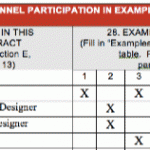
Specialists have tools of their trade. Architects, engineers, and contractors are great examples. You use software like Microstation, Revit, P6, and Contract Manager to do your job. You use these tools to help you build projects.
You could create a construction schedule in Excel, but it’s going to be better and more useful in P6. You could create the drawings for a building in Windows Paint, but it will be easier and better to do it in AutoCAD or Revit. These tools have a level of sophistication beyond what the everyman uses on a daily basis.
Marketers, in turn, have their specialty tools. Page layout programs like InDesign, vector programs like Illustrator, and content management systems like WordPress help them create marketing pieces beyond what can be done with the normal everyday tools.
You can create a proposal or an ad in Microsoft Word. It probably won’t look nearly as compelling. You can create a website in Word as well. Again, it wouldn’t be a great choice of tool.
Principals sometimes struggle with this. Why don’t we just do all our proposals in Word? Well, you can. But quality of the presentation will always be lesser than if it were done in InDesign.
It’s akin to planning your complex construction project in Excel. It can be done, but not like it can in P6. Excel is a spreadsheet program. P6 is a scheduling program. They are two entirely different things.
Similarly, Word is a word processor. InDesign is a page layout program. They are two entirely different things. They don’t work the same way. If you give someone a Word file, they can’t just open it in InDesign. They’ll have to import it into a layout.
In Word, you can cut a paragraph and paste it into a different location in your document. All the other text will automatically shift to accommodate that.
But if you cut a portion of an InDesign layout and paste it into the next page, everything else doesn’t automatically shift. You’ll likely have to rearrange not only the pages you just changed, but also the ones that follow. A “simple change” like that could mean an hour or more of rework.
It might not make sense to you, but that’s the point of the software: precise page layout. You can’t do that in Word.
That’s why magazines, newspapers, advertisements, and even book covers are created in page layout programs. People need precise control of the layout to make something that looks compelling.
You have to respect the skill set of the marketers who use these tools. You have to accept that these tools are fundamentally different than the tools you use to complete everyday tasks.
Unless you work in these programs, it is foolish to make assumptions about the level of effort required to do any particular thing with them.
If you liked this article, please subscribe below or on the right side of the homepage. If you want to give us your thoughts on this issue, please leave a comment below.





I agree. Some employers will balk at the cost of InDesign, Photoshop, etc. but will be quick to comment on “how professional” a proposal looks in comparison to a competitors. We can’t tell a client that we’re on top of our game, invest in the latest technology, etc. when proposals are looking amateurish, at best.
Another issue I am having is with justifying video editing platforms and software. As we have begun to add video to our social media efforts I have found the tools I am using clunky, slow and not very professional. I would be interested to know if others are doing more rich media and what tools they find necessary. I have been pushing for Mac and Final Cut Pro but my boss is saying, “You don’t need that. Use a PC based software.”
I think Adobe has video editing software for PC.
Adobe’s Premiere Pro is a very powerful video editing tool, and is included in the Adobe Creative Cloud Suite for Mac or PC. I work in Southern California, and a number of people that I know in the film and television industry use Premiere, especially if they are already using Illustrator and Photoshop to create content.
However, just as with every other Adobe product I have tried to learn, Premiere can have a pretty steep learning curve at the beginning.
Everything I know about Adobe products, I learned from their “classroom in a book” series.
Great post. It’s hard for busy people, under timeline pressure to master the seemingly endless array of tools to do their jobs. But if your job is close deals with proposals, you want the best tools available to maximize your sales. Word is clearly the most popular tool for proposals, while InDesign is popular with graphic and we designers, but both involve excessive amounts of manual work to get out a proposal. By moving to an online system (yes, like Mimiran), you can store templates, pricing info, product descriptions, and other content in one place, so you can craft nice looking proposals quickly.
In the A/E/C world, I’m not so sure Word is the most commonly used software for proposals. I’ve never used proposal automation, even though my version of Deltek says it does that.
I love on-line systems for their ability to store information so that I can access it quickly and efficiently. And using built-in templates can definitely reduce the time to create a final product, but I have never yet been satisfied with the final output of a file created by a template–I always need to do some tweaking to meet the requirements of the specific project. And I want to use a program that allows me to makes those tweaks as simply and efficiently as possible–for me that is almost always InDesign.
I generally agree that InDesign will allow for PRECISE layout management, but I don’t think that Word should be dismissed as a tool for writing proposals. Word can also be a great tool, and it requires a high technical skill to use effectively. I actually prefer Word to InDesign for proposal writing, and I accept that I may be in the minority.
Hey Nancy, You are drawing a conclusion from my article that just isn’t there. I’m not dismissing any tools.
Hi Matt–just discovered your site, and am enjoying all the information immensely.
In respect to Nancy’s comment above–I have and do use MS Word frequently, and am very proficient with the program. The real difference that I see between the two programs is that Word has been designed to be easy for a standard user, and automates some of the variables so that a standard user doesn’t need to think about them-things like line spacing, inserting graphics, page numbering, bulleted lists, etc..
But, when I have a project that requires me to adjust these standards (like a proposal with a strict page limit), it can be difficult or impossible to override some of these features in Word, and I often spend more time fighting to make Word do what I want it to do than I spend on actually preparing the proposal content. And for me, that is the definition of the wrong tool for the job.
humm interesting article. It makes sense. Thanks for the insight.